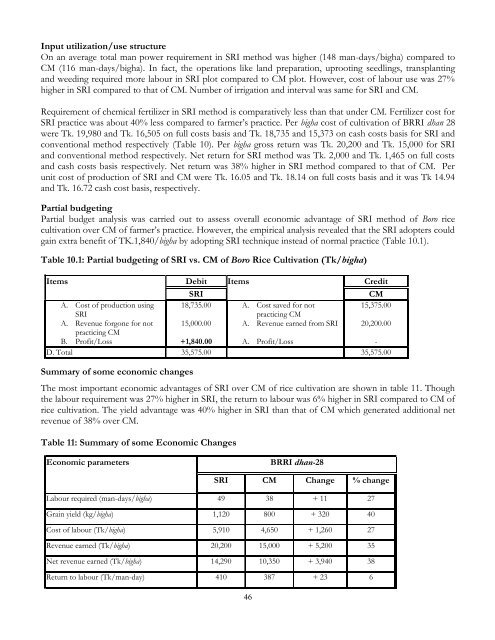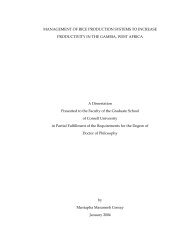Revised proceedings - The System of Rice Intensification - Cornell ...
Revised proceedings - The System of Rice Intensification - Cornell ...
Revised proceedings - The System of Rice Intensification - Cornell ...
Create successful ePaper yourself
Turn your PDF publications into a flip-book with our unique Google optimized e-Paper software.
Input utilization/use structure<br />
On an average total man power requirement in SRI method was higher (148 man-days/bigha) compared to<br />
CM (116 man-days/bigha). In fact, the operations like land preparation, uprooting seedlings, transplanting<br />
and weeding required more labour in SRI plot compared to CM plot. However, cost <strong>of</strong> labour use was 27%<br />
higher in SRI compared to that <strong>of</strong> CM. Number <strong>of</strong> irrigation and interval was same for SRI and CM.<br />
Requirement <strong>of</strong> chemical fertilizer in SRI method is comparatively less than that under CM. Fertilizer cost for<br />
SRI practice was about 40% less compared to farmer‟s practice. Per bigha cost <strong>of</strong> cultivation <strong>of</strong> BRRI dhan 28<br />
were Tk. 19,980 and Tk. 16,505 on full costs basis and Tk. 18,735 and 15,373 on cash costs basis for SRI and<br />
conventional method respectively (Table 10). Per bigha gross return was Tk. 20,200 and Tk. 15,000 for SRI<br />
and conventional method respectively. Net return for SRI method was Tk. 2,000 and Tk. 1,465 on full costs<br />
and cash costs basis respectively. Net return was 38% higher in SRI method compared to that <strong>of</strong> CM. Per<br />
unit cost <strong>of</strong> production <strong>of</strong> SRI and CM were Tk. 16.05 and Tk. 18.14 on full costs basis and it was Tk 14.94<br />
and Tk. 16.72 cash cost basis, respectively.<br />
Partial budgeting<br />
Partial budget analysis was carried out to assess overall economic advantage <strong>of</strong> SRI method <strong>of</strong> Boro rice<br />
cultivation over CM <strong>of</strong> farmer‟s practice. However, the empirical analysis revealed that the SRI adopters could<br />
gain extra benefit <strong>of</strong> TK.1,840/bigha by adopting SRI technique instead <strong>of</strong> normal practice (Table 10.1).<br />
Table 10.1: Partial budgeting <strong>of</strong> SRI vs. CM <strong>of</strong> Boro <strong>Rice</strong> Cultivation (Tk/bigha)<br />
Items Debit Items Credit<br />
SRI CM<br />
A. Cost <strong>of</strong> production using 18,735.00 A. Cost saved for not<br />
15,375.00<br />
SRI<br />
practicing CM<br />
A. Revenue forgone for not<br />
practicing CM<br />
15,000.00 A. Revenue earned from SRI 20,200.00<br />
B. Pr<strong>of</strong>it/Loss<br />
+1,840.00 A. Pr<strong>of</strong>it/Loss<br />
-<br />
D. Total 35,575.00 35,575.00<br />
Summary <strong>of</strong> some economic changes<br />
<strong>The</strong> most important economic advantages <strong>of</strong> SRI over CM <strong>of</strong> rice cultivation are shown in table 11. Though<br />
the labour requirement was 27% higher in SRI, the return to labour was 6% higher in SRI compared to CM <strong>of</strong><br />
rice cultivation. <strong>The</strong> yield advantage was 40% higher in SRI than that <strong>of</strong> CM which generated additional net<br />
revenue <strong>of</strong> 38% over CM.<br />
Table 11: Summary <strong>of</strong> some Economic Changes<br />
Economic parameters BRRI dhan-28<br />
SRI CM Change % change<br />
Labour required (man-days/bigha) 49 38 + 11 27<br />
Grain yield (kg/bigha) 1,120 800 + 320 40<br />
Cost <strong>of</strong> labour (Tk/bigha) 5,910 4,650 + 1,260 27<br />
Revenue earned (Tk/bigha) 20,200 15,000 + 5,200 35<br />
Net revenue earned (Tk/bigha) 14,290 10,350 + 3,940 38<br />
Return to labour (Tk/man-day) 410 387 + 23 6<br />
46

















